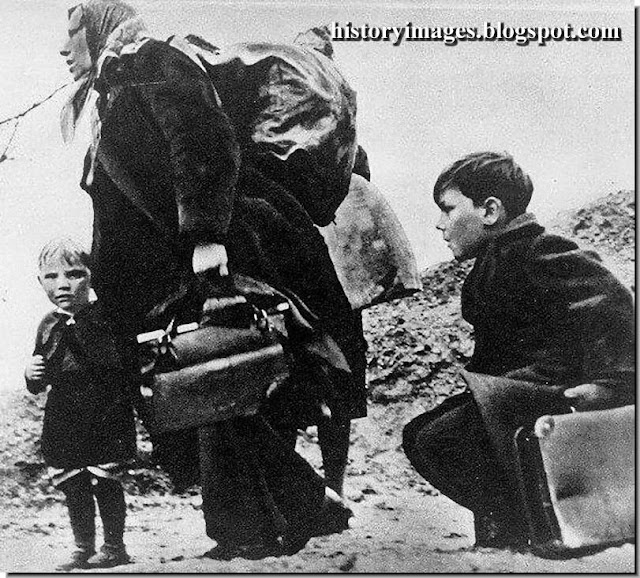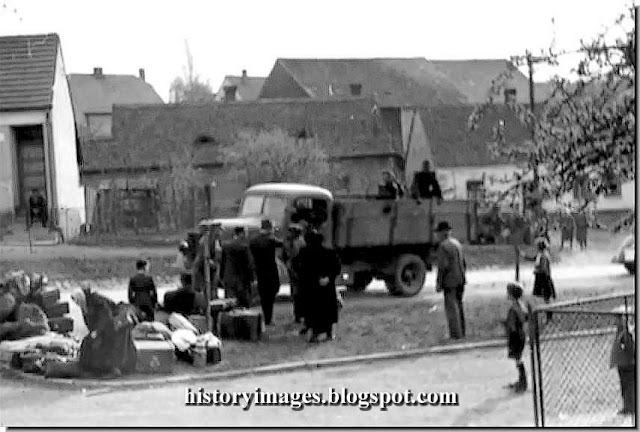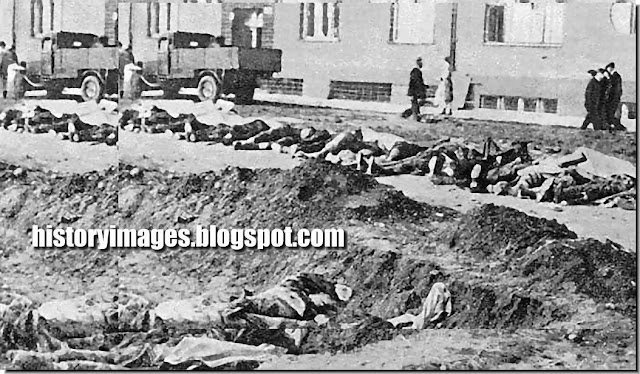Czech revenge began in Prague May 5, 1945. Although the written record documents these atrocities (Giles MacDonogh details them in his book, After the Reich), the German news daily Spiegel revealed June 2, 2010 that a newly discovered film, hidden for years, has been recovered. The events in the film took place on May 10, 1945 in Prague. According to Jan Puhl, writing in Spiegel, the film shows Germans being taken out of a cinema, led to a nearby meadow, and shot. The wounded were crushed to death by a Red Army truck. Cinemas and schools were used to imprison Germans awaiting death or deportation. The collective cry, “Death to all Germans” signaled massive reprisals against all Germans. Giles MacDonogh likens the killing frenzy to the days of the French Reign of Terror. He writes that the Czechs were backed by the Red Army and believed that the Allies “would turn a blind eye to all that happened.”
For decades, the images lay forgotten in an aluminum canister -- almost seven minutes of original black and white film, shot with an 8 mm camera on May 10, 1945, in the Prague district of Borislavka during the confusing days of the German surrender.
The man who shot the film was Jirí Chmelnicek, a civil engineer and amateur filmmaker who lived in the Borislavka district and wanted to document the city's liberation from the brutal Nazi occupation. Chmelnicek filmed tanks rolling through the streets, soldiers and refugees. Then, at some point, his camera also caught groups of Germans, who had been driven out of their houses and into Kladenska Street by Red Army soldiers and Czech militiamen. Chmelnicek's film shows how the Germans were rounded up in a nearby movie theater, also called the Borislavka. The camera then pans to the side of the street, where 40 men and at least one woman stand with their backs to the lens. A meadow can be seen in the background. Shots ring out and, one after another, each person in the line slumps and falls forward over a low embankment. The injured lying on the ground beg for mercy.
Then a Red Army truck rolls up, its tires crushing dead and wounded alike. Later other Germans can be seen, forced to dig a mass grave in the meadow.
The first casualty on the Aussig Bridge was a young German woman with her baby. Surrounded and clubbed to death, she and the baby were thrown into the Elbe River. Writer Douglas Botting states that, “…within three hours up to 2,700 more Germans had been murdered on the bridge or in the main square…”
Other Germans were taken to the former Nazi concentration camp Theresienstadt, which was being used to incarcerate Germans. Rhona Churchill, writing in the London Daily Mail, detailed the May 30, 1945 Brno death march when 25,000 men, women and children were marched to the Austrian border but refused entry. Her article begins, “Here is what happened when young revolutionaries of the Czech National Guard decided to ‘purify’ the town.” Unable to go anywhere, the people were placed in a field. With sparse food rations, no shelter, and disease, many rapidly died.
A May 12, 2010 interview on Radio Prague (published on their web site) with Marie Ranzenhoferova, a survivor, details the death march. In many cities, Germans were dispossessed of all assets, forbidden to receive ration cards for food, and held to a curfew. MacDonogh writes that, “There was to be no mercy for old men, women or children – even for German dogs.” Some Germans were used as human torches.
The psychological motivation was in reaction to the excesses of the war time Nazi occupation. The occupying Wehrmacht garrison occupying Brno had not surrendered the city (analogous to Ostrava and Prague), and the Allies had to seize it by force. Shortly after the war ended, the Czechoslovak government began expelling from the country its large ethnic German minority (over 3 million people, mostly along the German and Austrian borders). Those living in Brno were forced on a march 56 kilometres (35 mi) south towards the Austrian border. Few of the victims were men, since most male adults had been conscripted into the Wehrmacht and were by then prisoners of war.
A greater tragedy than expulsion was to befall the expellees after the Soviet authorities refused to allow them to enter their sector of Austria. (Austria had been divided into four occupation zones, and Moravia bordered the Soviet Occupation Zone.) The Brno Germans were marched back to the city and were interned in the village of Pohořelice (today part of Brno). What happened next is controversial. About 700 are confirmed as dying, either by disease (shigellosis) or by murder.
Some German sources claim that between 1300–8000 died, but these figures are not supported by the evidence. The communist agent Bedřich Pokorný, who had organized the 31 July 1945 Ústí massacre of hundreds of ethnic Germans in Ústí nad Labem (German: Aussig an der Elbe), was also behind the Brno event.
-----------------------------
All citizens of Brno, whether they were of Czech or German nationality, lived a happy Easter in early April. But no one could have known that for most of Brno Germans who stayed here, it was to be the last Easter in their homeland. Even before the war over 58,000 Germans has lived in Brno.
During the retreat of German troops about 60% of them left either voluntarily or in pursuant to the order Nero, Hitler issued, directing the departure of the Germans against advancing Soviet troops. The last special train with the Germans, who fled from the front, left Brno on April 18.
When the city was liberated April 26, 1945, in Brno remained about 25,000 Germans and we can say that those who stayed had a clear conscience. They said it: "Our family has been living here for generations, here I was born, I did not do anything to anyone, so what would happen to me?" A position, which was shortly afterwards to be bitterly regretted not knowing that the end would come to the German part of Brno. Most of them thought that the Czechs and Germans would live together after the war, will live again as before, as they had done so for centuries. Many were connected by marriage and ethnically mixed families spoke Czech and German. Also, most of the other participating members spoke both languages perfectly. Czechs and Germans lived in Brno harmoniously side by side for centuries, and Brno had a bilingual culture.
What the Reich and the Gestapo did to the Czechs, was suddenly blamed on the Germans and Brno. Systematic mongering Benes saw to it that all the hatred turned against the Germans, who stayed here. And they found themselves virtually unprotected, exposed to the unbridled vengeance. In accordance with the Benes words of collective guilt, they were sentenced regardless of guilt. It was enough they were German.
Their end came on the sad evening of 30 May 1945, when Germans who still remained in Brno - 20,000 women, children, invalids and elders, were expelled from their hometown. The Brno death march was the so-called "wild expulsion". What happened in the following days in Brno, Pohořelice and on the way to the Austrian border, was marked as a crime against humanity, ethnic cleansing, genocide.
.In his speeches Benes did not appeal for restraint as a wise statesman but he urged the collective disposal of all Germans. The floodgates opened, and the the implementation of terrible revenge was put entirely in the hands of a few perverted Czechs. Do you want German property? Go and take it! He will defend? Kill him! Go, choose a German woman and rape her! Everything is permitted!
Excesses against the Germans reached drastic proportions. The order of the day was cruel sadistic torture. After the violent occupation of houses and looting houses, and there were rapes and murders. On the streets Germans were hunted down; many people were wounded, beaten, hanged, burned alive or shot. There were Czech witnesses of the German human torches. There were Germans in the street hanging upside down with lamps and gasoline burning below. Flogging their backs and pouring salt into the wounds. The executions also occurred in places of internment of Germans and even the sick, wounded and disabled were not spared.
Various criminals, including wartime collaborators, gendarmes, soldiers Svoboda and others killed with enthusiasm, because they were guaranteed immunity by self-styled president Benes.
And the legendary Brno death march radiated long-suppressed hatred not only for the Nazis, who, moreover, did not attend the march at all, but especially for the German children, women and old people. In Brno, Germans were herded in concentration camps.
And there Benes' countrymen, tortured them, raped women and girls. Self-appointed guards showed the incredible brutality of the not only Czech but also of Russian soldiers. The surviving Germans remember that the Russians behaved more decently with German women, old men and children than the Bohemian civilians.
Mstitelům and self-styled Bohemian robbers managed to rid unwanted population. The people's courts of justice and self-appointed bailiffs tried Germans diligently in all towns and villages and executed them. They committed other atrocities and brutality - torture, burning alive, electrocution, multiple rape. There were brutal beating with sticks of the German population, their gold teeth punched out, their naked bodies burnt. The Germans were beaten in the streets, beaten with sticks, shot, bayonets and dumped into the river. Gunmen of the newly formed Red Guards ruthlessly tortured and murdered citizens of German nationality in internment camps.
Many camps became suppliers of women for an orgy of Soviet troops. People died from malnutrition, accidents, epidemics and violence. In all cases there was clearly organized violence and it was not just a case of isolated individuals acting against the excesses of the German population, as some historians try to downplay this period.
The Germans were robbed on the streets, guards conducted unlimited searches, looting, raping, shooting. No wonder that this mass phenomenon in May and June led to suicide amongst the Germans and their numbers increased with an increasing sense of danger. There were suicides, often of entire families.
There was brutal multiple rape of German women and girls, regardless of their age, health status and the presence of other persons, including children. Rychlokvašení Patriots hunted women and shipped them off to the Red Army soldiers to satisfy their low appetites.
A few days later she saw Germans being chased across a field like hares, gunned down by partisans with submachine guns. Her family was thrown out of their house on the 9th and made to run the gauntlet down their street while the crowd lashed out at them. She spotted some of their neighbours weeping at their windows at the sight.
They joined a group of refugees. Many of them were bloody, after Czechs had hurled grenades into their midst. For the second time the seventeen-year-old Erika heard that she and the better-looking Germans would be raped by the Russians. They apparently had first refusal. The Russians, however, treated her well. She fainted, and was pulled into a car by the hair. She woke on a sofa bound hand and foot. Five high-ranking Soviet officers asked her if she were hungry, and where she wanted to go. She said she wanted her mother. They took her to the football stadium where she found her mother and younger brother.
After threatening to shoot them all, Czechs took the Germans to Masshaupt where they had to stand in a ditch while a crowd spat on them and pelted them with stones. They were then returned to the football stadium on a lorry. There were German soldiers lying all around with bullet wounds in their stomachs and heads. Erika’s party were stripsearched and taken to a barracks. Bodies were strewn everywhere, even small children whose parents had cut their throats to save them from further tortures.
This idyll changed when on the 17th some lorry-loads of armed Czech partisans arrived. All the male German inhabitants were hunted into the main square. By the early afternoon there were as many as a thousand. The Czechs amused themselves by drilling them, forcing them to lie down and get up, all the while walking among them, spitting and kicking them in the groin and shins. Those who fell during this humiliation were taken to a water tank and drowned. Any who bobbed up were shot.
Meanwhile a ‘People’s Court’ had been established with a jury composed of local Czechs. The Germans had to crawl to the bench. Most of the men then had to run a 50–60 metre gauntlet. Many fell and were beaten to pulp. The next day the chaos 138 survivors were reassembled. One man was strung up from a lamppost. The court adjourned only when a horrified woman set fire to her house which threw the crowd into a panic. Twenty-four Germans had been killed. An even greater number committed suicide.
Related
Germans Killed and Expelled From Czechoslovakia After WW2
Suggested Reading

Forced Migration in Central and Eastern Europe, 1939-1950




















































0 Comments:
Post a Comment